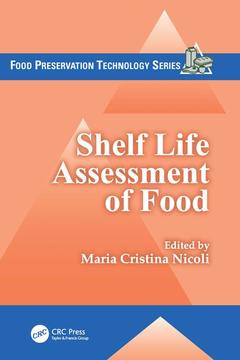Shelf Life Assessment of Food Food Preservation Technology Series
Coordonnateur : Nicoli Maria Cristina

Determining accurate shelf life data for foods is essential for assuring food quality and protecting consumers from the effects of degradation. With a proper balance of theory and practical examples, Shelf Life Assessment of Food presents the essential criteria and current methodologies for obtaining accurate and reliable shelf life dating. Defining the process through a series of sequential steps, the book assists and supports researchers and food industry operators in planning a shelf life study that best suits their needs.
Offering an integrated view of the present status of shelf life assessment, the book covers:
- Definitions, basic concepts, and regulatory aspects of food shelf life
- The shelf life assessment process, including preliminary steps, testing, modeling, and monitoring
- Methods for determining acceptability limits
- Critical indicators in shelf life assessment
- Real-time and accelerated shelf life testing
- Microbial indicators for shelf life prediction and determination
- Survival analysis methodologies and their role in modeling shelf life
- The effect of packaging materials properties in food shelf life assessment
The book concludes with a series of case studies involving fresh-cut apple slices, fruit juices, frozen pasta, cheese breadsticks, coffee, frozen shrimp, and fruit-based noncarbonated soft drinks. Each case study begins with a brief presentation of the product and the problem most relevant to the product?s shelf life. The studies first define acceptability limits and identify the indicators of quality loss. Next, the book examines expiration time assessment by instrumental or sensory tools.
Providing researchers and food industry operators with up-to-date data and procedures, this volume surveys the most critical factors and methods for obtaining accurate and reliable shelf life dating.
An Introduction to Food Shelf Life: Definitions, Basic Concepts, and Regulatory Aspects.The Shelf Life Assessment Process. The Acceptability Limit. Critical Indicators in Shelf Life Assessment. Modeling Shelf Life Using Chemical, Physical, and Sensory Indicators. Modeling Shelf Life Using Microbial Indicators. Modeling Shelf Life Using Survival Analysis Methodologies. Packaging–Food Interactions in Shelf Life Modeling. Case Studies. Index.
Maria Cristina Nicoli’s research activity chiefly focuses on chemical and physical factors affecting food functionality and stability. The main topics are the effect of processing on the antioxidant properties of plant derived foods, antioxidant properties of Maillard reaction products, the effect of physical state on food stability and the development of food shelf life predictive models.
Date de parution : 11-2016
15.6x23.4 cm
Date de parution : 06-2012
Ouvrage de 326 p.
15.6x23.4 cm
Thème de Shelf Life Assessment of Food :
Mots-clés :
Shelf Life; Shelf Life Assessment; food shelf life; Shelf Life Studies; Consumer Rejection; shelf llfe estimation; Quality Depletion; shelf life prediction; Log10 Cfu; food dating; Quality Decay; accelerated shelf life testing; Critical Indicator; acceptability limit; Storage Time; food failure; Shelf Life Estimate; life testing; Interval Censoring; food stability; Fruit Juice; kinetic modeling; Orange Juice; survival analysis; Accelerating Factor; ASLT; Survival Analysis Approach; Linear Regression; Case Study; HPH Treatment; Shelf Life Models; Deteriorative Events; Pasteurized Orange Juice; Dynamic Temperature Conditions; Assess Shelf Life; Apricot Juice



